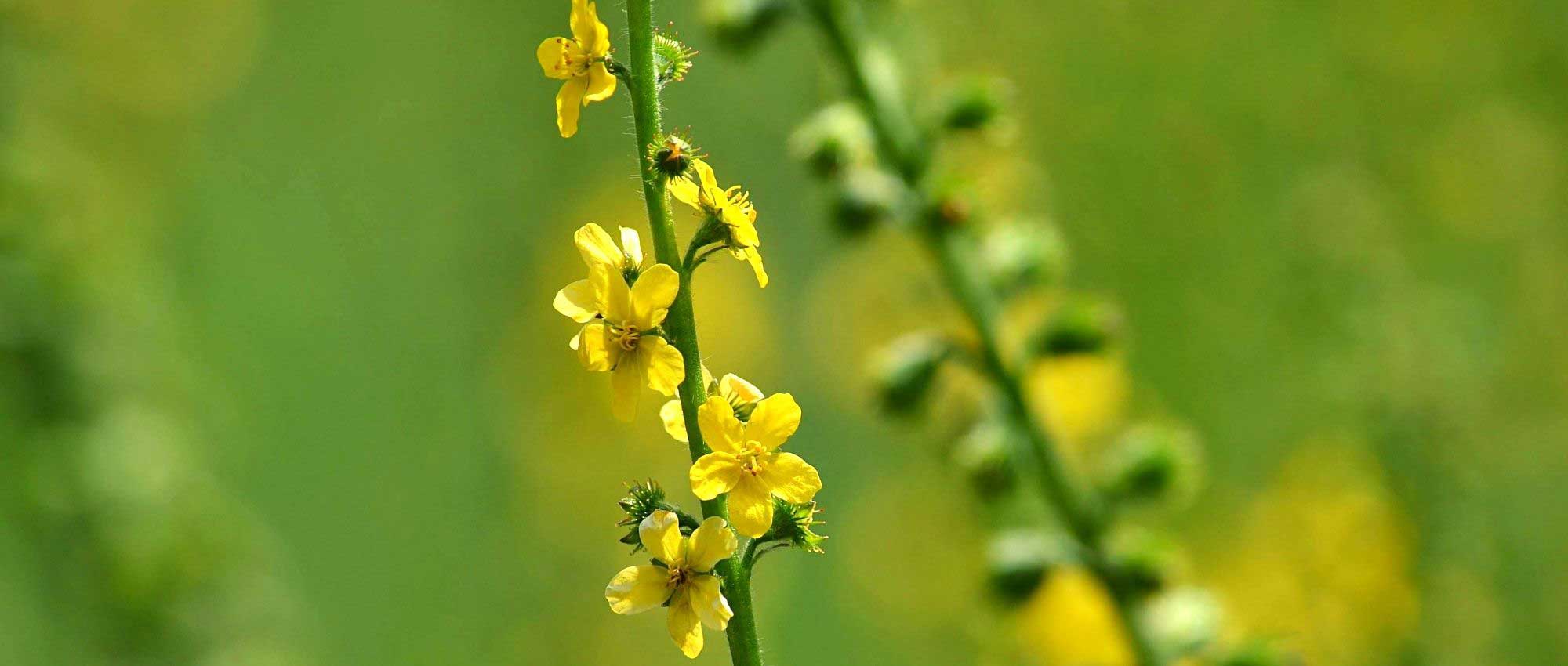
Agrimony: planting, growing, benefits
Contents
Agrimony in a nutshell
- Agrimony is a lovely perennial that bears fine yellow flower spikes in summer.
- Quite discreet and delicate, it integrates easily into naturalistic gardens.
- It is also a plant with medicinal virtues and dyeing properties.
- It thrives in the sun, in fresh, rich, and well-drained soil.
- Easy to grow, it requires little maintenance and is perfectly hardy.
A word from our expert
Agrimony is a lovely perennial that bears delicate floral spikes of bright yellow flowers in summer, very luminous! Its foliage, divided into dentate leaflets, is also appreciated. However, agrimony is primarily known for its numerous medicinal properties. It has been recognised since antiquity for strengthening the respiratory system, combating insomnia, diarrhoea, sore throats, skin conditions, and more. It is used in capsules or as a mother tincture.
Very delicate, it is valuable for adding small touches of light to borders without being exuberant or gaudy. It has the charm of wild plants! It will naturally find its place in a naturalistic garden or a medicinal plant garden. It is mainly known for its yellow flowering, but there is also a variety with white flowers: Agrimonia eupatoria ‘Alba’.
Very easy to grow, once established, agrimony requires little maintenance. Moreover, it is perfectly hardy and can self-seed in the garden. It is ideal for areas of the garden left wild, where intervention is rare.
Botany
“`html
Botanical data
- Latin name Agrimonia eupatoria
- Family Rosaceae
- Common name agrimony, old man's tea, wood tea, Saint William's herb…
- Flowering summer, from June to September
- Height between 30 and 60 cm
- Sun exposure full sun or partial shade
- Soil type cool, draining, rich and humus-bearing
- Hardiness between -15 and -20 °C
Agrimony is a herbaceous perennial plant. There are 18 different species, mainly from temperate regions of the Northern Hemisphere, but the best-known is Agrimonia eupatoria (not to be confused with Eupatoriums, such as Eupatorium maculatum!). It can be easily found in the wild in France, across the entire metropolitan territory. It grows at the edge of woods, along paths, in fields, meadows, clearings, and uncultivated areas… It is a nitrophilous and bio-indicator plant: it naturally grows in nitrogen-rich soils.
Agrimony is part of the large family of Rosaceae. It is therefore a cousin of roses, but also of most cultivated fruit trees (apple trees, pear trees, cherry trees, raspberry bushes, strawberry plants…), as well as many ornamental plants, such as avens, potentillas, meadowsweet, and lady’s mantle.
The name agrimony comes from the Greek Argemônê, which refers to an eye ulcer, against which the plant was once used. The species name (eupatoria) comes from Mithridates VI Eupator, king of Pontus (132 – 63 BC), who discovered its virtues.
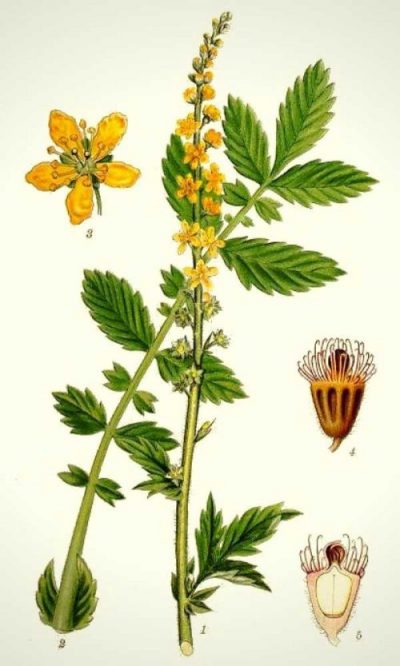
Agrimonia eupatoria: botanical illustration
Agrimony is a medicinal plant with numerous properties, used since antiquity. It was used by the Romans and Greeks, as well as other Mediterranean peoples. In the Middle Ages, it was believed to have magical properties. Its ancestral use has given it several common names: old man’s tea, wood tea, Saint William’s herb…
Agrimony is rich in tannins, silica, and flavonoids. Its richness in silica makes it remineralising, like horsetail. It has tonic, anti-inflammatory, and astringent properties. It is generally used in infusions, which gives it the nickname “wood tea”. It aids digestion, strengthens the respiratory system, protects and repairs mucous membranes. It is indicated for insomnia, diarrhoea, menstrual problems, sore throats, coughs, skin conditions, kidney issues… It is also used by singers to strengthen their vocal cords and prevent voice loss.
In addition to its many medicinal properties, it can also be used as a dye plant, to dye wool and cotton. It gives them a beautiful golden yellow colour.
It is also possible to make agrimony wine by fermenting leaves or flowers in sweetened water.
Agrimony is also edible, but has little culinary interest.
Agrimony forms a rosette of leaves, from which a stem rises bearing leaves and flowers. It generally reaches heights of 50-60 cm, but sometimes more, up to 1 m. The stems of agrimony are simple or weakly branched. They are pubescent and more or less reddish.
Although discreet when not in flower, agrimony nonetheless has a lovely dissected foliage. The leaves are divided into 5 to 9 large dentate leaflets, oval to lanceolate, interspersed with much smaller leaflets. The leaves are said to be odd-pinnate: composed of an odd number of leaflets, with a terminal leaflet. They are inserted alternately on the stem (one leaf after another), and are white and downy on the underside.

The flowering in fine clusters (photo Andrey Zharkikh), the detail of the flowers (photo Joan Simon), and the dissected foliage of Agrimonia eupatoria.
Agrimony flowers in summer, from June to September. It then produces upright, long, and fine clusters, consisting of small yellow flowers with five petals and five sepals (like most Rosaceae!). These flowers measure about 1 cm in diameter. They open successively from the bottom of the stem to the top. The flowers are hermaphroditic, bearing both male (stamens) and female (pistil) organs. There are between 5 and 20 stamens. The flowers are borne on a solitary, unbranched spike. They are slightly fragrant, reminiscent of apricot or citrus scents. In the garden, agrimony flowers are appreciated for their very bright hue! They catch the eye and bring dynamism to the flower beds, without being overly exuberant.
Agrimony is a melliferous plant that attracts bees, hoverflies, and butterflies. They come to consume the nectar of the flowers and simultaneously transport pollen from one plant to another.
Since agrimony is quite rarely cultivated, there are not many horticultural varieties. However, there is one with white flowers: Agrimonia eupatoria ‘Alba’! This white hue is very rare among agrimonies, most species having yellow flowers.
The fruits of agrimony are achenes, each containing one to two seeds. They have the particularity of being equipped with small hooks that allow them to cling to the fur of animals or clothing. This allows the plant to disperse its seeds far from the original plant. In the garden, agrimony tends to self-seed spontaneously.

After flowering, agrimony produces fruits equipped with hooks that cling to the fur of animals to disperse the seeds they contain! (photos Agnieszka Kwiecień, Nova)
“`
Read also
Agrimony: 5 successful pairing ideasThe main varieties of agrimony
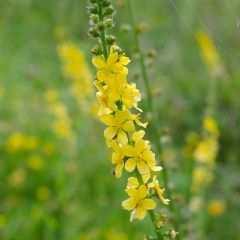
Agrimonia eupatoria
- Flowering time July to October
- Height at maturity 40 cm
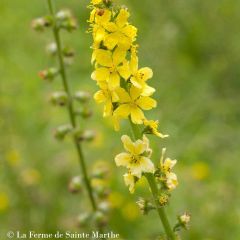
Agrimony - Ferme de Sainte Marthe seeds
- Flowering time July to October
- Height at maturity 50 cm
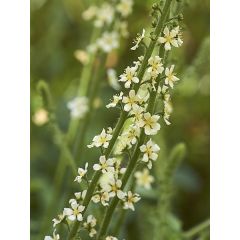
Aigremoine eupatoire 'Alba'
- Flowering time July to October
- Height at maturity 60 cm
There are not many horticultural varieties of agrimony, but there are different species: Agrimonia procera (which also grows in France), Agrimonia gryposepala, Agrimonia pilosa, Agrimonia striata, Agrimonia parviflora… The Agrimonia parviflora has very beautiful foliage, formed of long and slender leaflets. However, it is rare in cultivation!
Discover other Agrimony
View all →Available in 1 sizes
Available in 1 sizes
Planting
Where to plant agrimony?
Plant agrimony preferably in full sun, or in partial shade. It enjoys cool, well-draining, rather rich and humus-bearing soils. In fact, it is a nitrophilous plant that naturally grows in nitrogen-rich soils. However, agrimony is not fussy; it will also thrive in poor and relatively dry soil. It will simply look more beautiful and develop better if planted in cooler, richer soil. Regarding pH, agrimony prefers neutral or alkaline soils but can also grow in slightly acidic soil.
Feel free to place it in a part of the garden that you allow to evolve naturally, intervening rarely.
For a more attractive effect, we recommend planting several young plants together, maintaining a distance of about 40 cm between them.
When to plant?
Plant agrimony in spring, around April, or in autumn.
How to plant?
- Dig a planting hole two to three times the size of the root ball.
- Add some well-decomposed compost to enrich the soil.
- Gently remove the agrimony from its pot.
- Place it in the planting hole.
- Fill in around it with soil, taking care not to bury the basal leaves.
- Water generously.
Continue to water in the weeks following planting until the agrimony is well established.
Entretien
As it grows naturally in France, at the edge of woods and in uncultivated areas, agrimony requires very little maintenance. Water regularly in the weeks following planting to help it settle and develop its root system. Afterwards, only water occasionally when you notice that the soil is dry. However, be cautious of excess moisture, which could lead to powdery mildew or root rot.
You can cut the flower stems when they have faded, or choose to leave them in place to give it a chance to self-seed!
Agrimony does not require more maintenance than these few precautions. It is a resilient plant, being little susceptible to diseases and pests. Moreover, if it thrives, there’s a good chance it will self-seed in the garden!
Harvest
The best time to harvest agrimony is when it is in full flowering, typically in July-August.
The aerial parts are used, mainly the leaves and flowers, as well as the stems if they are not too thick. Simply dry them by placing them in a dry, airy location, away from direct sunlight, and then store them in kraft paper bags or glass jars (provided they are completely dry, otherwise they may rot).
If you wish to use it as a tincture, harvest the leaves and flowers of agrimony at the end of summer. They should then be soaked in cold water, brought to a boil, and left to infuse for 1.5 hours.
Multiplication
Sowing
Sowing takes place in April.
We recommend stratifying the seeds in the refrigerator for one to two months before sowing. This will help break the dormancy of the seeds and promote good germination.
- Prepare a pot with potting soil, then lightly firm it and level the surface.
- Sow the seeds.
- Cover with a thin layer of potting soil (about twice the size of the seed).
- Water gently
- Place the pot in a bright location, out of direct sunlight.
- Ensure the substrate remains slightly moist until germination. Seeds take between 10 and 25 days to germinate.
- As soon as the seedlings are large enough to handle, repot them into individual pots or plant them outdoors (provided there is no longer a risk of frost).
You can also sow the seeds directly in the garden in early spring.
It is also possible to divide clumps of agrimony in autumn.
Association
With its very delicate style, agrimony is ideal for a naturalistic garden. We recommend pairing it with flowers that have a light and airy habit, such as gaura, Buenos Aires verbena, carders, echinops, thistles, and knauties… Don’t forget the grasses – like Stipas, Chinese fountain grasses, and Molinies – which are essential for giving your garden a wild meadow feel!
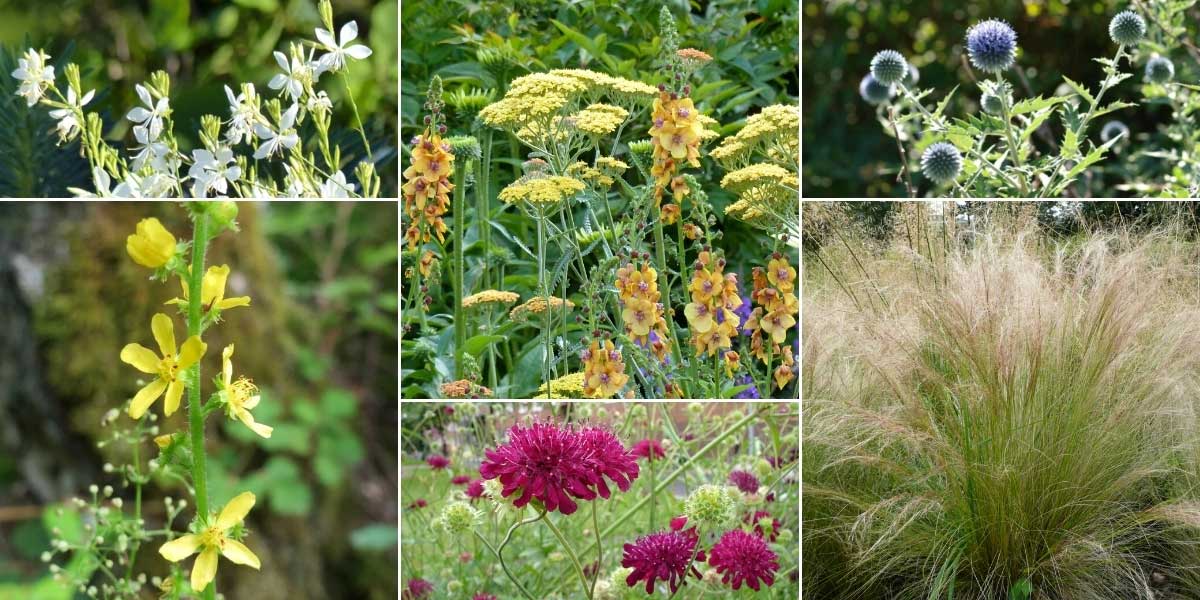
Agrimony integrates easily into a naturalistic garden! Gaura lindheimeri ‘Snowbird’, Achillea ‘Terracotta’ and Verbascum ‘Helen Johnson’, Echinops sphaerocephalus (photo F. D. Richards), Agrimonia eupatoria, Knautia macedonica (photo Epibase), and Stipa tenuifolia
Agrimony will easily fit into a vicar’s garden. This style of garden, once confined to the surroundings of churches and monasteries, brings together a beautiful diversity of vegetables, medicinal plants, fruit trees, and flowers (which were historically intended to adorn the altar). We recommend organising it in raised beds, possibly bordered by woven fences. For vegetable plants, favour old and forgotten varieties: parsnip, horseradish, cardoon, orache, sorrel, Jerusalem artichoke, lovage… Also integrate aromatic and medicinal plants, such as common sage, chamomile, marigold, comfrey, and agastache…
Take advantage of agrimony to create a vibrant flowerbed in shades of yellow, orange, and red. For example, plant it alongside heleniums, coreopsis, bidens, achilleas, and rudbeckias. And for a touch of exoticism, rely on the flowering of crocosmias and kniphofias! This will give you a beautiful luminous and dynamic effect.
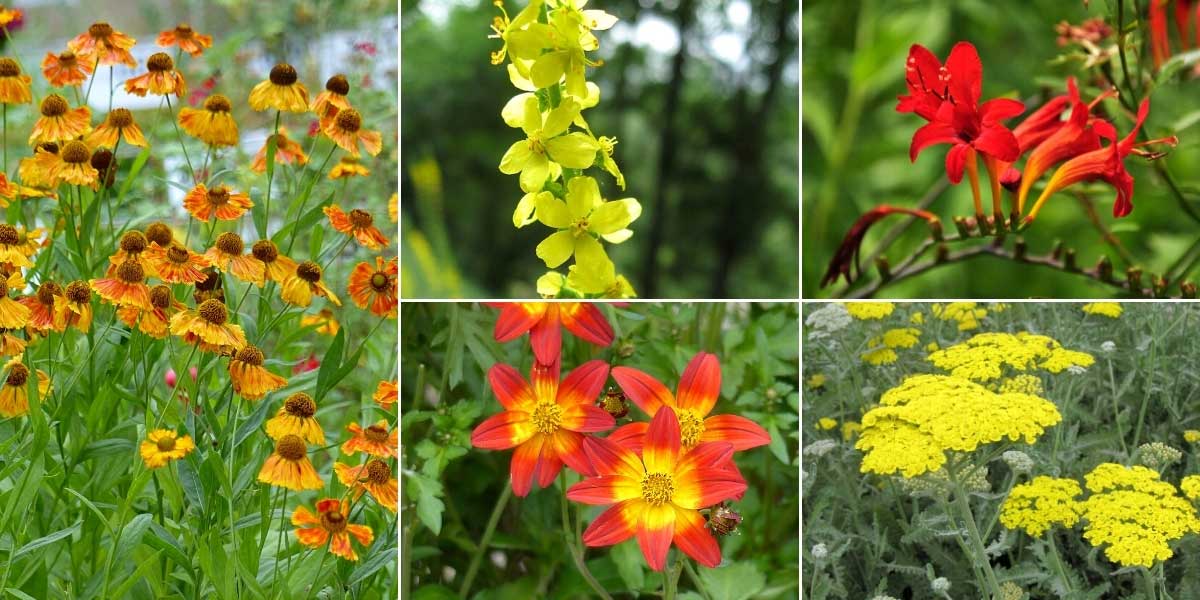
Don’t hesitate to accompany agrimony with blooms in warm and bright tones! Helenium ‘Waltraut’, Agrimonia eupatoria (photo Joan Simon), Crocosmia masoniorum, Bidens ‘Campfire Fire Wheel’, and Achillea ‘Moonshine’
You can also play with complementary colours: these shades that are opposite each other on the colour wheel, such as yellow and purple, or orange and blue. By combining them, you achieve a contrasting effect, full of relief, as these colours enhance each other. You can thus pair the yellow flowers of agrimony with purple blooms, such as those of Nepeta ‘Six Hills Giant’, Penstemon ‘Sour Grapes’, agapanthus ‘Poppin Purple’, campanulas, and Salvia nemorosa… Also enhance the yellow shade with achillea ‘Moonshine’, coreopsis, and Rudbeckia fulgida… This will create a very original flowerbed that attracts the eye and does not go unnoticed!
→ Discover also 5 successful pairing ideas with Agrimony
Useful resources
- Discover 5 pairing ideas with agrimony
- Discover our young plants and our agrimony seeds
- To pair agrimonies: discover our inspiration page “Naturalist Garden”
- An article from the Sauvages du Poitou blog on eupatory agrimony
- Subscribe!
- Contents































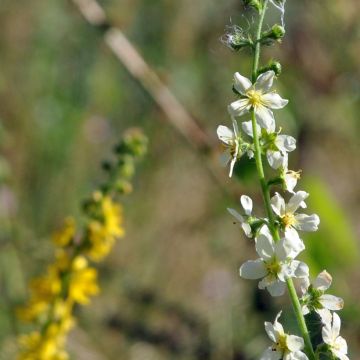

Comments